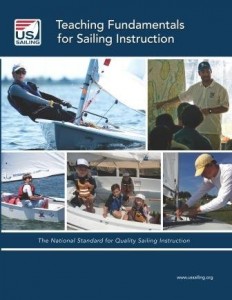
US Sailing
5 Stars Perhaps the best teaching/coaching “best practices” overview I have ever read
This volume complements – with some overlap but certainly worth reading on its own merits – the US Naval Offshore Sail Training Squadron Experiential Leadership Guide, which cites this books as recommended additional reading.
Worthy of immediate and continuous note is the opening emphasis on the legal responsibility of a sailing instructor – a duty of care with attendant legal obligations and a vulnerability to being sued if all four of the following can be proven:
1. The instructor had a legal duty to the injured party
2. The instructor failed to fulfill their duty
3. The injury occurred to the party to whom the instructor had a legal duty
4. The failure of the instructor to fulfill their duty was the cause of the injury
The three common defenses for negligence available to an instructor are:
1. Show all of the elements of negligence were not present
2. Show the direct causes of the injury were an act of God (forces of nature)
3. Show the injured party is guilty of contributory negligence (he or she caused the injury) with comparative negligence (apportioned fault) being an alternative to instructor absolution
I learn that US Sailing members who are certified instructors are covered by a US Sailing $10 million liability policy in addition to that offered by their sailing school employers.
The legal liability is a helpful means of emphasizing the total nature of a sailing instructor's responsibility, and also helpful in showing how the balance of this book is an instructor's best defense: attention to detail, checklists, prior preparation, record keeping, and reflection including notes after each lesson are how an instructor demonstrates due diligence apart from the student's as witnesses to successful attentive respectful instruction.
The other eye opener for me is the early emphasis on how important it is for the instructor to both avoid any possible perception of sexual harassment, intimacy (including the application of sun screen), or abuse in dealing with young people – to include never being alone with one of them (I am also a Boy Scout volunteer, this is the core mandate in their Youth Protection policy). I also learn that the instructor has a legal obligation to bring to the attention of the authorities any concerns about abuse that might surface to the instructor.
With as the cautionary introduction, I move on to the substance which is as fine as I have ever encountered – this is world-class material with no fluff.
CORE: safety is your duty, fun is your delivery, and learning is your outcome. If the student does not have fun they might not stick with sailing. If the student does not learn it is your failing as an instructor.
A major shared view between this book and the US Naval Academy focus on leadership training and particularly experiential leadership through small unit offshore sailing where actions have life-affirming consequences is on the importance of understanding the everyone learns differently – most learn visually, some learn through hearing and some learn through doing. The ideal instruction combines all three, detects and respects differences in learning styles, and strives to inspire the student to be a partner in learning.
I learn that the largest difference between self-learning through online courses and printed material, and taught instruction, is FEEDBACK. The book overall is extremely well developed as a guide to instructors in how to be most effective at offering feedback, including the feedback “sandwich” that integrates positive observations with even-handed SPECIFICS on what needs work.
The recommended instructor style is that of cooperative or collaborative learning, in which students are fully engaged. The bracketing styles, not recommended, are the autocratic or dictatorial style (in academia this is called didactic – “I talk you listen”) and the equally harmful wimp style (their word), unsure and lacking in any semblance of leadership. BALANCE is the word that comes to my mind.
There is an enormous amount of value in this book for anyone of any age (I am 63) who wishes to reflect on their leadership and teaching/coaching style. I am impressed by the manner in which the book discusses every possible aspect of how an instructor comes across from use of words, timing, eye contact, posture, and so on.
The book includes a section on creating and following and improving lessons plans; ten steps of risk management (alone worth the price of the book); a number of sample forms including emergency management forms; and a list of 23 record-keeping areas. That last is more important than I realized before reading this book – record-keeping is part of due diligence, part of being a good instructor, and a foundation for doing well, safely, while meeting our legal “duty of care” obligations.




